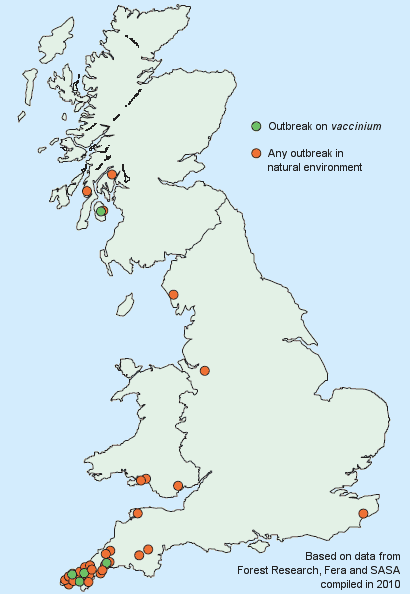Origins
Phytophthora kernoviae, first isolated from a beech tree canker sample by Forest Research scientists, is yet another invasive Phytophthora found to be causing damage and mortality to trees in the UK in the past decade. Related pathogens include the hybrid alder P. alni, and the ‘sudden oak death’ pathogen P. ramorum, P. lateralis and P. austrocedrae.
Most of these Phytophthoras were unknown to science until recently and are likely to have been introduced via international plant trade.
The geographical origins of P. kernoviae are still debated. It is a pathogen that grows best at around 18 °C with an upper limit of 26 °C which suggests it is adapted to a temperate climate. This could indicate a possible origin in the temperate forests of the eastern Himalaya, China or Taiwan. Another possible origin is Patagonia, because of its infection of Chilean hazelnut (Gevuina avellana). More recent reports from New Zealand and Chile also suggest a Southern Hemisphere origin for this Phytophthora species.
UK distribution
Most sites affected with Phytophthora kernoviae are located in south west England. They include woodland, open heath bilberry sites and occasional reports of isolated infections on ornamental shrubs and trees in gardens.
The most up-to-date map information and host list on the Defra Plant Health Portal [https://planthealthportal.defra.gov.uk/pests-and-diseases/high-profile-pests-and-diseases/phytophthora/].
Incidence in rhododendron and bilberry (UK)
Rhododendron (typically R. ponticum) is the primary host for P. kernoviae. Thousands of these plants have been infected, mainly in south west England where the pathogen is probably more virulent to rhododendron than P. ramorum.
Our research shows that bilberry (Vaccinium myrtillus) is also highly susceptible to Phytophthora kernoviae; and infection among plants spreads through open heath and causes extensive dieback.
Incidence in trees (UK)
Our research and monitoring at infection sites suggests that trees in close proximity (<5 m) to diseased rhododendron are at risk of infection through the transfer of spores from the infected leaves of the rhododendron plants.
A few hundred European beech trees (Fagus sylvatica) have been infected in this way, mainly in the south west. It was also found infecting two oak (Quercus robur) trees. Forest Research first isolated P.kernoviae from a beech bleeding canker in 2003.
On infected sites Phytophthora kernoviae Infection has been confirmed in the following species:
A small number (five or fewer trees) of other tree species have also been infected:
There are reports of infection in a tulip tree (Liriodendron tulipifera), a Chilean hazelnut (Gevuina avellana) and a single ivy plant (Hedera helix).
P. kernoviae around the world
Apart from the UK, the Republic of Ireland is the only other country in Europe where Phytophthora kernoviae has been found.
In March 2006, the New Zealand Ministry of Agriculture and Forestry announced that P. kernoviae had been detected in two separate localities on the North Island in New Zealand. At one of the sites it was infecting the shoots and fruit of cherimoya or custard apple (Annona cherimola) in an orchard, at the other site – the Trounson Kauri Park – it was isolated from soil under Pinus radiata. Annona cherimola is an exotic species from South America. In 2014, Phytophthora kernoviae was also reported from Chile infecting Drimys winteri (winter’s bark).
These reports of Phytophthora kernoviae in the Southern Hemisphere, and findings of disease in Southern Hemisphere hosts in the UK (Podocarpus, Drimys and Gevuina), all point to a possible origin from this part of the world.
Phytophthora kernoviae outbreaks in UK
